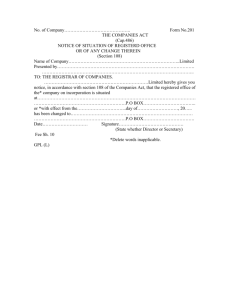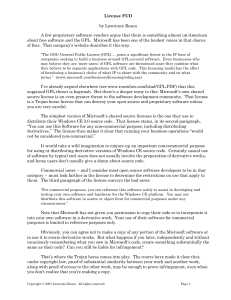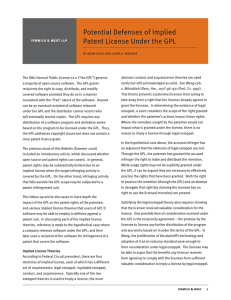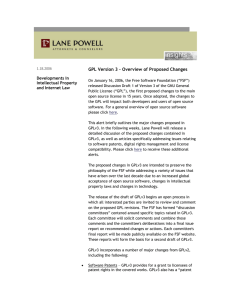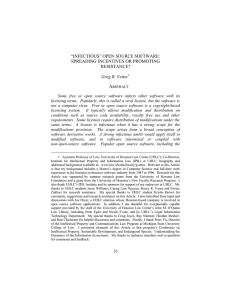Scenarios of Co-existence Between Proprietary and Open
advertisement
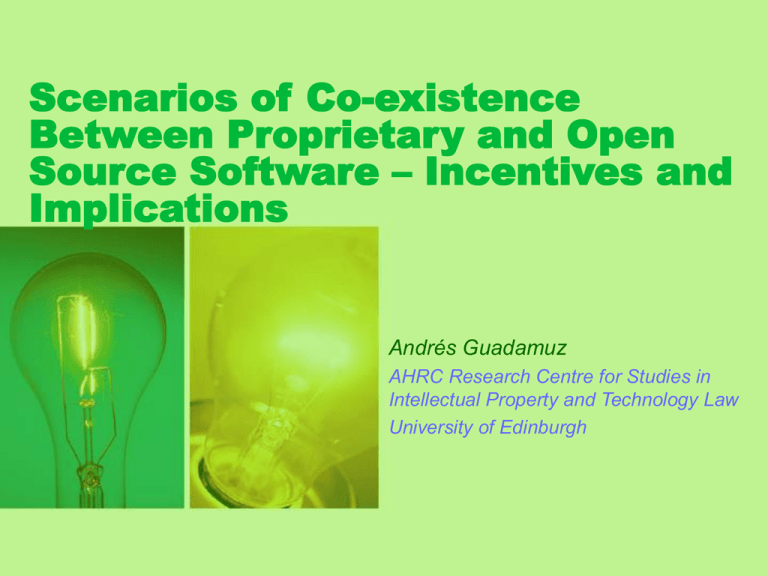
Scenarios of Co-existence Between Proprietary and Open Source Software – Incentives and Implications Andrés Guadamuz AHRC Research Centre for Studies in Intellectual Property and Technology Law University of Edinburgh OSS 2006 Conference Como, Italy Free Libre Open Source Software as a global brand Hacker sharing ethics • "information-sharing is a powerful positive good, and that it is an ethical duty of hackers to share their expertise by writing free software and facilitating access to information and to computing resources wherever possible". • "Information increases in value by sharing it with other people. Data can be the basis for someone else's learning; software can be improved collectively“ The Cathedral and the Bazaar Three different takes on FLOSS History of Nonproprietary Software • Unix OS, 1969-1970 • Sharing of source code by Unix developers, 1970-1979 • Berkeley Software Distribution (BSD) 1980 • Richard Stallman forms the Free Software Foundation (FSF) 1984 • Linus Torvalds and Linux circa 1991 • Open Source term coined in 1998 Free Software • Movement created from the growing disillusionment by Richard Stallman with proprietary software. • Certain freedoms must be kept, particularly the freedom to access the source code. • Free in free software does not mean free as in having no price, but rather free as in “liberty”. 1. 2. 3. 4. The freedom to run the program, for any purpose. The freedom to study how the program works, and adapt it to your needs (access to the source code). Freedom to redistribute copies. The freedom to improve the program, and release improvements to the public, so that the whole community benefits. Open Source Initiative • Open source is deemed less restrictive than FS. • There are hundreds of licences in existence. • Open Source Initiative (OSI) is a non-profit organisation that certifies OSS licences. • There are 58 approved OSS licences, this includes FS licences. Definition of Open Source • Free Redistribution. • Source code will be made available for examination. • Must allow the development of derived works. • License may allow restrictions to changes to the original code if distributor assumes the responsibility of fixing bugs. Definition of Open Source (2) • No Discrimination against persons or groups. • No Discrimination against fields of endeavour. • No need for additional licenses for other people who get software. • If software distributed within larger software bundle, the software will still be subject to the larger product license. • The license must not restrict other software within same distribution. Software typology • Proprietary software – Closed source commercial software – Proprietaryware (demos) – Shareware – Freeware – Abandonware • Non-proprietary software, – Public domain – Free Software (FS) – Open Source (OSS) • Commercial software – Software licensed for a fee – Both proprietary and nonproprietary Sharing Create Modify Share Closed derivatives Create Modify Sell Copyleft • Actually, it is not the opposite of copyright , in fact, it uses copyright for protection. • Copyleft is a licensing method by which the work is protected by copyright, but it will have a specific clause that allows a work to remain “open” through a sharealike or viral clause. • Openness in this context means that the original work and whatever derivatives must remain available to the public in one way or another. General Public License (GPL) v2 • Drafted by Richard Stallman and Eben Moglen. • 68% open source projects use the GPL. • It reads part ideological manifesto, part legal document. • Allows licensees to use and distribute the software. • Contains “viral” element, all works that are derived from the licence must be distributed with the GPL. • Allows commercial use in some cases. Copyleft clause in the GPL • “2(b) You must cause any work that you distribute or publish, that in whole or in part contains or is derived from the Program or any part thereof, to be licensed as a whole at no charge to all third parties under the terms of this License.” GPL v3 • The new GPL version of the GPL is available for comment. • It is longer, and more complex than its predecessor. • It contains several controversial clauses: – Boosted viral clause (it now may apply to other software included with the GPL software). – Restricts the use of Technical Protection Measures. – Includes a patent licence. – Contains a conditional clause: users of GPL-licensed software should not initiate patent infringement suits. The new viral clause • b) You must license the entire modified work, as a whole, under this License to anyone who comes into possession of a copy. • These requirements apply to the modified work as a whole. If identifiable sections of that work, added by you, are not derived from the Program, and can be reasonably considered independent and separate works in themselves, then this License, and its terms, do not apply to those sections when you distribute them as separate works for use not in combination with the Program. But when you distribute the same sections for use in combination with covered works, no matter in what form such combination occurs, the whole of the combination must be licensed under this License, whose permissions for other licensees extend to the entire whole, and thus to every part of the whole. Are they valid? • Copyleft licences under scrutiny in the United States with RedHat v SCO. • GPL has been found to be valid under German Law. • GPL found valid in Brazil. • Efforts underway to “nationalise” licences, for example, CC-UK and the French GPL. Coexistence Distribution chain Author / Owner Licensee / Derivative Derivative Licensee / User User User Licensee / Distributor User Distributor Derivative Dual licensing Commercial Distribution OSS Distribution Commercial licensee Sub-licensee Commercial licensee Support agreement Commercial licensee End-user Trouble ahead? Incompatibility issues • GPL may not be compatible with your licensing strategy. • Case Scenario 1: Using GPL’d software internally and to produce commercial applets does not require GPL redistribution. • Case Scenario 2: Using GPL’d code, changing it as part of a proprietary package requires that the software should be released under GPL. SCO v IBM • Number of cases from SCO against IBM and OSS corporate users. • SCO claims Linux kernel infringes its intellectual property in UNIX. • Analysis of the claim indicates that it’s spurious. • However, courts have not thrown out case. • At least the cases should test GPL in the USA (RedHat v SCO). • What if it all goes wrong? The coming patent war? Pre-emptive strategy 1 (IBM) • IBM has declared that it will not enforce 500 software patents if they are used by open source developers. • “Legally binding non-assertion commitment”. This is a contract in most legislations. • IBM obtained 3,000 software patents in 2004, and owns about 30,000 in total. Pre-emptive strategy 2 (Apache) • “3. Grant of Patent License. Subject to the terms and conditions of this License, each Contributor hereby grants to You a perpetual, worldwide, non-exclusive, no-charge, royalty-free, irrevocable (except as stated in this section) patent license to make, have made, use, offer to sell, sell, import, and otherwise transfer the Work, where such license applies only to those patent claims licensable by such Contributor that are necessarily infringed by their Contribution(s) alone or by combination of their Contribution(s) with the Work to which such Contribution(s) was submitted. If You institute patent litigation against any entity (including a cross-claim or counterclaim in a lawsuit) alleging that the Work or a Contribution incorporated within the Work constitutes direct or contributory patent infringement, then any patent licenses granted to You under this License for that Work shall terminate as of the date such litigation is filed.” Pre-emptive strategy 3 (Patent Cooperation Agreement) • “Microsoft, on behalf of itself and its Subsidiaries (collectively “Microsoft”), hereby covenants not to sue Novell’s Customers and Novell’s Subsidiaries’ Customers for infringement under Covered Patents of Microsoft on account of a such Customers’ use of specific copies of a Covered Product as distributed by Novell or its Subsidiaries (collectively “Novell”) for which Novell has received Revenue (directly or indirectly) for such specific copies; provided the foregoing covenant is limited to use by a Customer of Novell (i) of such specific copies that are authorized by Novell in consideration for such Revenue, and (ii) within the scope authorized by Novell in consideration for such Revenue.” What’s at stake? The world… Population… Licence fee exports (2002) Licence fee imports (2002) Thank you a.guadamuz@ed.ac.uk
